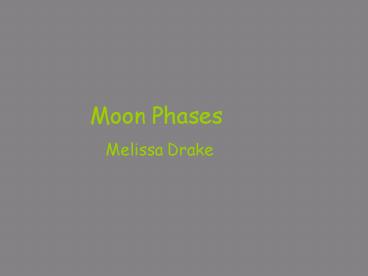Moon Phases - PowerPoint PPT Presentation
1 / 16
Title:
Moon Phases
Description:
The week after a new moon, it has completed the first of its way around the sun. ... each day to a tiny sliver before the process starts over to a new moon. ... – PowerPoint PPT presentation
Number of Views:120
Avg rating:3.0/5.0
Title: Moon Phases
1
Moon Phases
- Melissa Drake
2
Why does the moon have different phases?
3
Because
- The moon doesnt produce light of its own
- Moonlight we see is the sunlight reflected on the
moon surface
4
Moon Phase Types
- New Moon
- Waxing Crescent Moon
- First Quarter Moon
- Full Moon
- Waning Gibbous Moon
- Last Quarter Moon
- Waning Crescent Moon
5
New Moon
- Occurs when the moon is roughly the same
direction as the sun. The dark part of the moon
that is facing earth is called the New Moon.
6
Waxing Crescent Moon
- When more of the illuminated part of the moon
shows, its called waxing. It starts as a tiny
sliver then grows each day.
7
First Quarter Moon
- The week after a new moon, it has completed the
first ¼ of its way around the sun.
8
Waxing Gibbous Moon
- Waxing means growing, and as the week continues
the moon begins to illuminate more each day.
9
Full Moon
- At two weeks, the moon has completed half its
cycle. The moon then is half way facing the sun
and half way towards earth.
10
Waning Gibbous Moon
- From the full moon after the moon begins to
decrease, before it was increasing. This is why
its called Waning.
11
Last Quarter Moon
- Three weeks have gone by now. The moon now shows
the last ¼ of the moon.
12
Waning Crescent
- Is last of the moons phases and it is slowly
decreasing each day to a tiny sliver before the
process starts over to a new moon.
13
Moon Statistical Facts
- Mass 73'490'000'000'000'000 million kg
- Shape Egg-shaped
- Distance from earth384'467 km
- (364 397 km at perigee,
406 731 km at apogee) - Diameter 3476 km (1/4 of the Earth's)
- Revolution period 27.3217 days
- http//www.moonphases.info/Moon_Information
14
Interesting Moon Facts
- Rotation of moonThe same side of the Moon
always faces the Earth. The Moon's rotation
period is synchronous with its revolution period
around the Earth - Sun and Moon EclipsesAn eclipse of the Sun can
occur only at New Moon, while an eclipse of the
Moon can occur only at Full Moon. - (http//www.moonphases.info/Moon_Information)
15
Interesting Facts about the Moon
- Calculation of the Easter dateEaster is the
first Sunday after the first Saturday after the
first full moon after the equinox. (The equinox
is quite often March 21, but can also occur on
the March 20 or 22.)
http//www.moonphases.info/Moon_Information
16
Cool Websites about the moon
- http//www.scienceu.com/observatory/articles/phase
s/phases.html - http//stardate.org/nightsky/moon/index.php?month
5year2007cssmoon.cssSubmitGo - http//www.moonphases.info/moon_phases.htmlMonths
_without_a_full_moon































